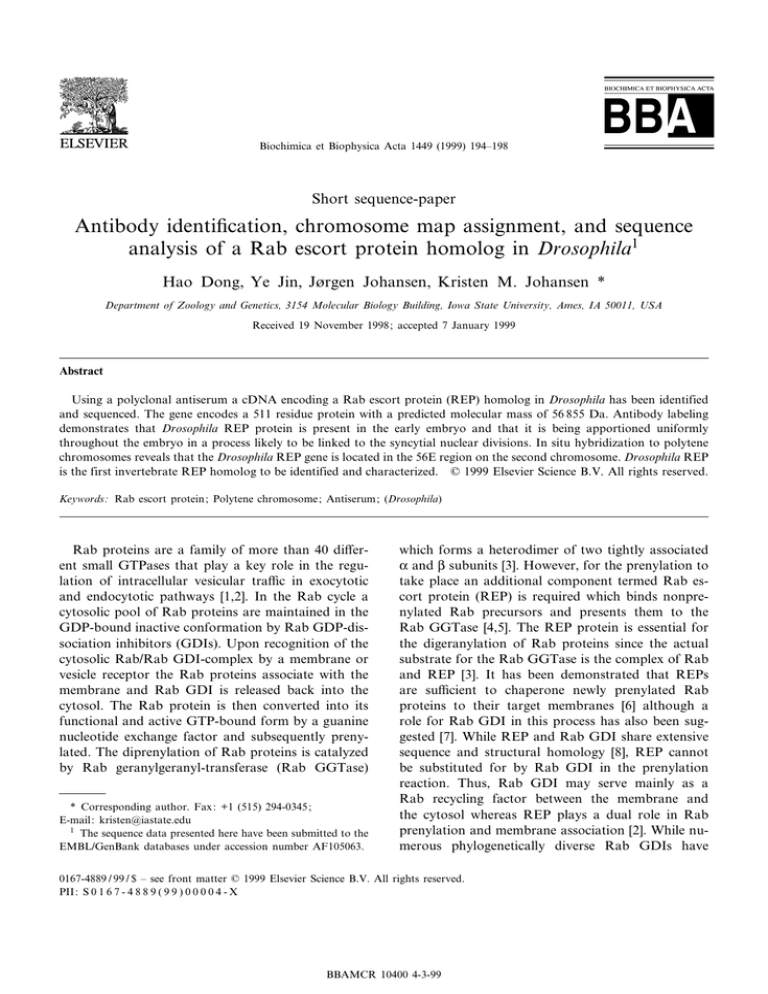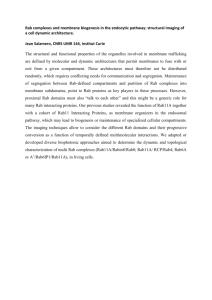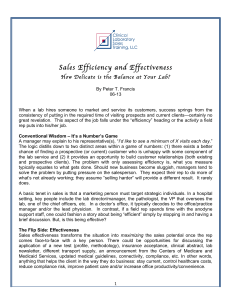
Biochimica et Biophysica Acta 1449 (1999) 194^198
Short sequence-paper
Antibody identi¢cation, chromosome map assignment, and sequence
analysis of a Rab escort protein homolog in Drosophila1
Hao Dong, Ye Jin, JÖrgen Johansen, Kristen M. Johansen *
Department of Zoology and Genetics, 3154 Molecular Biology Building, Iowa State University, Ames, IA 50011, USA
Received 19 November 1998; accepted 7 January 1999
Abstract
Using a polyclonal antiserum a cDNA encoding a Rab escort protein (REP) homolog in Drosophila has been identified
and sequenced. The gene encodes a 511 residue protein with a predicted molecular mass of 56 855 Da. Antibody labeling
demonstrates that Drosophila REP protein is present in the early embryo and that it is being apportioned uniformly
throughout the embryo in a process likely to be linked to the syncytial nuclear divisions. In situ hybridization to polytene
chromosomes reveals that the Drosophila REP gene is located in the 56E region on the second chromosome. Drosophila REP
is the first invertebrate REP homolog to be identified and characterized. ß 1999 Elsevier Science B.V. All rights reserved.
Keywords: Rab escort protein; Polytene chromosome; Antiserum; (Drosophila)
Rab proteins are a family of more than 40 di¡erent small GTPases that play a key role in the regulation of intracellular vesicular tra¤c in exocytotic
and endocytotic pathways [1,2]. In the Rab cycle a
cytosolic pool of Rab proteins are maintained in the
GDP-bound inactive conformation by Rab GDP-dissociation inhibitors (GDIs). Upon recognition of the
cytosolic Rab/Rab GDI-complex by a membrane or
vesicle receptor the Rab proteins associate with the
membrane and Rab GDI is released back into the
cytosol. The Rab protein is then converted into its
functional and active GTP-bound form by a guanine
nucleotide exchange factor and subsequently prenylated. The diprenylation of Rab proteins is catalyzed
by Rab geranylgeranyl-transferase (Rab GGTase)
* Corresponding author. Fax: +1 (515) 294-0345;
E-mail: kristen@iastate.edu
1
The sequence data presented here have been submitted to the
EMBL/GenBank databases under accession number AF105063.
which forms a heterodimer of two tightly associated
K and L subunits [3]. However, for the prenylation to
take place an additional component termed Rab escort protein (REP) is required which binds nonprenylated Rab precursors and presents them to the
Rab GGTase [4,5]. The REP protein is essential for
the digeranylation of Rab proteins since the actual
substrate for the Rab GGTase is the complex of Rab
and REP [3]. It has been demonstrated that REPs
are su¤cient to chaperone newly prenylated Rab
proteins to their target membranes [6] although a
role for Rab GDI in this process has also been suggested [7]. While REP and Rab GDI share extensive
sequence and structural homology [8], REP cannot
be substituted for by Rab GDI in the prenylation
reaction. Thus, Rab GDI may serve mainly as a
Rab recycling factor between the membrane and
the cytosol whereas REP plays a dual role in Rab
prenylation and membrane association [2]. While numerous phylogenetically diverse Rab GDIs have
0167-4889 / 99 / $ ^ see front matter ß 1999 Elsevier Science B.V. All rights reserved.
PII: S 0 1 6 7 - 4 8 8 9 ( 9 9 ) 0 0 0 0 4 - X
BBAMCR 10400 4-3-99
H. Dong et al. / Biochimica et Biophysica Acta 1449 (1999) 194^198
195
Fig. 1. Immunohistochemical labeling of Drosophila syncytial embryos with Drosophila REP antiserum. (A) Drosophila REP is localized as evenly distributed punctate structures at interphase. The labeling is visualized using HRP-conjugated secondary antibody. (B)
At prophase the punctate antibody-positive structures congregate around the nuclei (arrows). (C) At metaphase the antibody labeling
is localized to the region of the asters of the mitotic spindle (arrows). (D) Confocal micrograph of the antibody-positive punctate
structures (bright white) in an embryo where the chromatin was counterstained with Hoechst (gray). The antibody labeling was visualized using a TRITC-conjugated secondary antibody. Scale bar equals 100 Wm in (A^C) and 30 Wm in (D).
been characterized, only two related mammalian
REP proteins, REP1 and REP2, and one Saccharomyces cerevisiae homolog have been identi¢ed to
date. REP1 in human is encoded by the X-linked
choroideremia (CHM) gene [9], while REP2 or
CHM-like gene [10] is located on chromosome 1
[11]. Deletion of the REP1 gene causes a progressive
retinal dystrophy leading to complete degeneration
and blindness by middle age. In yeast, one gene of
REP (MRS6/MSI4) has been identi¢ed [12]. This
gene is required for cell viability [13], suggesting
that there may be only one REP gene in yeast.
Here we report on a polyclonal antiserum which
we have used to clone and characterize the full length
sequence of a Drosophila REP homolog.
We have been interested in protein localization
and distribution during syncytial nuclear divisions
in Drosophila embryos [14]. Embryos in Drosophila
begin with a single zygotic nucleus which undergoes
eight synchronous mitotic divisions before the majority of the somatic nuclei migrate to the embryonic
peripheral cortex. Only after four more rounds of
mitotic cycles do membranes form between the nuclei
converting the syncytium into a cellularized blastoderm. During attempts to generate polyclonal antibodies to a GST-fusion protein of a novel nuclear
protein kinase, JIL-1 [14], that localizes to the nucleus and chromosomes throughout the cell cycle, we
obtained a rabbit serum which does not recognize the
nucleus or the JIL-1 protein but rather discrete punctate structures surrounding the nuclei of the syncytial
embryos (Fig. 1A). On immunoblots the antiserum
recognizes the antigen as a single band with an apparent molecular mass of 60 kDa (Fig. 2A). This is
in contrast to the nuclear protein JIL-1 which has a
predicted molecular mass of 158 kDa suggesting that
BBAMCR 10400 4-3-99
196
H. Dong et al. / Biochimica et Biophysica Acta 1449 (1999) 194^198
Fig. 2. Immunoblots of SDS-PAGE fractionated embryonic
Drosophila proteins labeled with Drosophila REP antiserum. (A)
The antiserum recognizes a single band with an apparent molecular mass of 60 kDa. (B) The antiserum labeling (control) is
abolished after preabsorbtion with 20 Wg of a partial Drosophila
REP-GST fusion protein (pRep-GST) but not by 20 Wg of GST
fusion protein only (GST).
the 60 kDa band represents a completely di¡erent
protein. Interestingly, the distribution of the antibody-positive structures during nuclear division in
the syncytial embryos appears to be linked to the
mitotic cycle. During prophase the punctate antibody-positive structures congregate around the nuclei (Fig. 1B) and during metaphase they are apportioned equally to the spindle poles (Fig. 1C)
colocalizing with the asters of the mitotic spindle.
At telophase the nuclei reform with each of the
duplicated nuclei associated with their half of the
punctate structures (Fig. 1D). This redistribution
probably re£ects a mechanism of apportioning maternally supplied proteins uniformly during the syncytial divisions in preparation for cellularization.
Since the localization and redistribution of the 60
kDa antigen clearly is coordinated with the mitotic
cycle we decided to determine its molecular identity.
To this end we screened 5U105 plaques of a Drosophila oligo-dT primed expression vector library with
the antiserum and a single partial positive cDNA
clone which included the poly A tail was identi¢ed.
Subsequently, another cDNA library was screened
with a radiolabeled nucleotide probe generated
from the 5P end of the original cDNA clone. From
this screen several overlapping cDNA clones were
isolated which are likely to encompass the entire coding sequence since it has a 5P ATG initiation codon
just downstream from an in-frame TAG stop codon.
The predicted sequence is for a protein containing
Fig. 3. The complete predicted amino acid sequence of Drosophila REP. Drosophila REP is a 511 residue protein with a calculated
molecular mass of 56 855 Da.
BBAMCR 10400 4-3-99
H. Dong et al. / Biochimica et Biophysica Acta 1449 (1999) 194^198
197
Fig. 4. Alignment and phylogenetic relationship of Drosophila REP with other REP and GDI proteins. (A) Alignment and position of
sequence conserved regions (SCR) [8] in REP and GDI proteins. (B) Alignment of Drosophila REP with mammalian REPs in SCR1
and SCR3. Shared amino acids are in white typephase outlined in black. Drosophila REP has approximately 70% amino acid identity
with these proteins in the SCRs. (C) Consensus maximum parsimony tree derived from the SCR regions of representative REP and
GDI proteins. The tree is rooted using sequences from yeast GDI. The strict consensus of 1000 maximum parsimony trees is depicted
with associated bootstrap support values.
511 residues (Fig. 3) with a calculated molecular
mass of 56 855 Da which is close to the 60 kDa
estimate for the antigen based on SDS-PAGE analysis (Fig. 2A). To further verify that the cloned protein indeed corresponded to the 60 kDa antigen and
the punctate staining in the syncytial embryos we
generated a GST-fusion protein containing the coding sequence of the original cDNA isolate identi¢ed
by the antiserum. A¤nity puri¢ed GST-fusion protein was then used for preabsorption of the antiserum. As shown in Fig. 2B preabsorption with GSTfusion protein of the antiserum completely abolished
staining on immunoblots whereas preabsorption with
GST protein was without e¡ect as compared with
control lanes. Likewise, immunocytochemical staining of syncytial embryos were eliminated by GSTfusion protein preabsorption but not by GST protein
alone (data not shown).
The complete sequence of the identi¢ed protein is
shown in Fig. 3 and it shares three highly sequence
conserved regions (SCRs) with other members of the
REP and Rab GDI families which have been shown
by site directed mutagenesis to be involved in the
binding of Rab proteins [8]. Fig. 4A shows the rela-
Fig. 5. In situ hybridization mapping of the Drosophila REP
gene to region 56E on salivary gland polytene chromosomes.
BBAMCR 10400 4-3-99
198
H. Dong et al. / Biochimica et Biophysica Acta 1449 (1999) 194^198
tive location of the SCRs in schematic diagrams of
the molecules to their N-terminal and central portions. Residues and sequence motifs in these regions
are particularly diagnostic of REP and GDI family
members owing to the composition of invariant diand tripeptides in evolutionarily divergent species
[8,15]. In contrast to GDIs and yeast REP the mammalian REPs are distinguished by containing a large
insert (138 amino acids) that separates SCR1 and
SCR2 [8]. Fig. 4B shows a sequence comparison of
the protein for SCR1 and 3 with the most homologous sequences in the data banks all of which belong
to the mammalian REP representatives suggesting
that we have identi¢ed a Drosophila REP homolog.
Thus, to further determine the evolutionary relationship between the identi¢ed protein and members of
the REP and GDI gene families we constructed phylogenetic trees based on maximum parsimony using
the PAUP computer program. Fig. 4C shows a consensus tree based on REP and GDI sequences from
the SCRs from di¡erent organisms. The tree is
rooted using sequences from yeast GDI as an outgroup; however, the same topology was obtained for
unrooted trees. The identi¢ed protein is clearly a
member of a monophyletic clade comprising mammalian and yeast REPs that is supported by a bootstrap value of 100% con¢rming its designation as a
Drosophila REP homolog.
In situ hybridization of polytene chromosomes revealed that the Drosophila REP gene maps to the
right arm of the second chromosome in the 56E region (Fig. 5). This region is relatively poorly characterized and we have not been able to identify any
previously reported mutations likely to correspond
to the Drosophila REP gene. However, the future
isolation and characterization of mutants defective
in REP in Drosophila, an animal amenable to genetic
manipulation, promises to provide further insights
into the function of this protein.
The authors wish to thank Anna Yeung for excellent technical assistance. This work was supported by
NSF Grant MCB 9600587 to K.M.J.
References
[1] S.R. Pfe¡er, Curr. Opin. Cell Biol. 6 (1994) 522^526.
[2] P. Novick, M. Zerial, Curr. Opin. Cell Biol. 9 (1997) 496^
504.
[3] P.J. Casey, M.C. Seabra, J. Biol. Chem. 271 (1996) 5289^
5292.
[4] D.A. Andres, M.C. Seabra, M.S. Brown, S.A. Armstrong,
T.E. Smeland, F.P. Cremers, J.L. Goldstein, Cell 73 (1993)
1091^1099.
[5] F. Shen, M.C. Seabra, J. Biol. Chem. 271 (1996) 3692^
3698.
[6] K. Alexandrov, H. Horiuchi, O. Steele-Mortimer, M.C. Seabra, M. Zerial, EMBO J. 13 (1994) 5262^5273.
[7] J.C. Sanford, J. Yu, J.Y. Pan, M. Wessling-Resnick, J. Biol.
Chem. 270 (1995) 26904^26909.
[8] I. Schalk, K. Zeng, S.K. Wu, E.A. Stura, J. Matteson, M.
Huang, A. Tandon, I.A. Wilson, W.E. Balch, Nature 381
(1996) 42^48.
[9] J.A. van den Hurk, M. Schwartz, H. van Bokhoven, T.J. van
de Pol, L. Bogerd, A.J. Pinckers, E.M. Bleeker-Wagemakers,
I.H. Pawlowitzki, K. Ruther, H.H. Ropers, F.P. Cremers,
Hum. Mutat. 9 (1997) 110^117.
[10] F.P. Cremers, S.A. Armstrong, M.C. Seabra, M.S. Brown,
J.L. Goldstein, J. Biol. Chem. 269 (1994) 2111^2117.
[11] M.D. Barbosa, S.A. Johnson, K. Achey, M.J. Gutierrez,
E.K. Wakeland, S.F. Kingsmore, Mamm. Genome 6
(1995) 488^489.
[12] R.M. Benito-Moreno, M. Miaczynska, B.E. Bauer, R.J.
Schweyen, A. Ragnini, Curr. Genet. 27 (1994) 23^25.
[13] A. Ragnini, R. Teply, M. Waldherr, A. Voskova, R.J.
Schweyen, Curr. Genet. 26 (1994) 308^314.
[14] K.M. Johansen, J. Cell. Biochem. 60 (1996) 289^296.
[15] M. Waldherr, A. Ragnini, R.J. Schweyen, M.S. Boguski,
Nature Genet. 3 (1993) 193^194.
BBAMCR 10400 4-3-99





